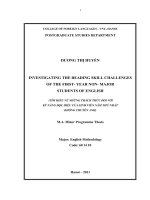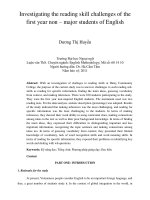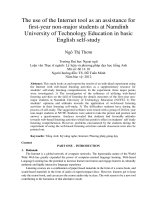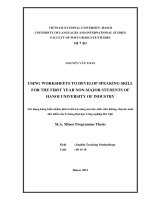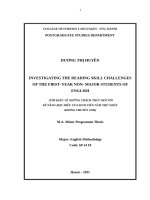Investigating the reading skill challenges of the first year non – major students of English
Bạn đang xem bản rút gọn của tài liệu. Xem và tải ngay bản đầy đủ của tài liệu tại đây (195.05 KB, 7 trang )
Investigating the reading skill challenges of the
first year non – major students of English
Dương Thị Huyền
Trường Đại học Ngoại ngữ
Luận văn ThS. Chuyên ngành: English Methodology; Mã số: 60 14 10
Người hướng dẫn: Dr. Hà Cẩm Tâm
Năm bảo vệ: 2011
Abstract: With an investigation of challeges to reading skills at Hatay Community
College, the purpose of the current study was to uncover challenges to such reading sub-
skills as reading for specific information, finding the main ideas, guessing vocabulary
from context, and making inferences. There were 100 students participating in the study.
They were the first year non-majored English students. The instrument used was two
reading tests. For the data analysis, statistic description (percentage) was adopted. Results
of the study indicated that making inferences was the most challenging, and reading for
specific information was the least challenging to the students. In terms of making
inferences, they showed their weak ability in using contextual clues, making connections
among ideas in the text as well as their poor background knowledge. In terms of finding
the main ideas, they expressed their difficulties in distinguishing important and less
important information, recognizing the topic sentence and making connections among
ideas too. In terms of guessing vocabulary from context, they presented their limited
knowledge of vocabulary, lack of word recognition skills and word meaning skills. In
terms of reading for specific information, they exposed their problems on identifying key
words and dealing with wh-questions.
Keywords: Kỹ năng đọc; Tiếng Anh; Phương pháp giảng dạy; Đọc hiểu
Content
PART ONE: INTRODUCTION
1. Rationale for the study
At present, Vietnamese people consider English to be an important foreign language, and
thus, a great number of students study it. In the context of global integration in the world, in
general, and in Viet Nam in particular, the demand for learning English gets stronger and
stronger. English is regarded as an indispensable tool for academic and career advancement. It
can’t be denied, therefore, that English is now the dominant language, especially in language
teaching programs in many schools.
In teaching and learning English as a foreign language in Viet Nam, reading seems to be
the most important and useful activity in language classes. Of the four language skills, reading
has always received a great deal of attention, which is emphasized by Carrell (1981: 1) that “For
many students, reading is by far the most important of the four macro skills in a second
language, particularly in English as a second or foreign language”. It is quite true in the case of
Hatay Community College (HTCC) context, where English has been the foreign language
dominating in the teaching and learning programs for 33 years. Also, in the same picture, reading
is the most important skill for students to master because reading texts exist new words and
grammar, which are main parts in their test papers.
Reading is an active process and the readers need to use reading skills to make them
attain good reading comprehension. According to Anderson (1999: 1), he said “With
strengthened reading skills, ESL/ EFL readers will make greater progress and attain greater
development”. It can’t be denied that reading skills support significantly to readers’ reading
comprehension. The better the reader uses reading skills, the better he/ she gains reading
comprehension. However, the fact is that it is very difficult for a reader to master all reading
skills because there are various sub-skills of reading comprehension. Therefore, (s)he is
suggested to master some basic reading skills in order to understand the author’s thought. Firstly,
he/she makes sure that he/she has no problems with vocabulary while reading, it means (s)he
gains word recognition skills and word meaning skills. Secondly, (s)he has good ability to
identify facts and details in the text. Thirdly, (s)he catches the main ideas of the text so (s)he will
understand the author’s message underlining printed words. Once readers lack one of these
skills, they will have trouble with the text they are dealing with, even they fail to understand
what the author wants to convey. Unfortunately, it is the fact that many students at HTCC are
struggling with reading because they lack one of these basic reading skills, which makes them
cope with a lot of difficulty in attaining their reading comprehension. From this fact, it is
necessary to find out challenges to reading skills in the English classrooms at HTCC so as to
promote students to get their better reading comprehension.
As a teacher of English, I myself think that it is essential to do a research on challenges to
reading skills my students encountered with the hope that the students can improve their reading
comprehension. As a result, I decide to choose the thesis title: “Investigating the reading skill
challenges of the first year non – major students of English”.
2. Aim of the study
The aim of the study is to investigate difficulties the first year non – major English students
at HTCC deal with reading skills. Therefore, the objective of this study is:
- to uncover what challenges to reading sub – skills the first year non – major students of
English at HTCC encountered.
It is hoped that the findings from this study will be of some benefits to both teachers and
students at HTCC.
3. Significance of the study
This study is significant for some reasons. Firstly, the study uncovers challenges to reading
sub- skills the students had to suffer. Secondly, this study would help teachers and students
realize a need to change current English teaching and learning method. Finally, it would enable
students to improve their reading skills significantly in order that they can obtain their better
reading comprehension.
4. Scope of the study
Dealing with challenges of all reading sub-skills is too broad for a study of this size.
Therefore, the study is only designed to examine such sub – skills of reading comprehension as
reading for specific information, finding the main ideas, guessing vocabulary from the context
and making inferences that the first year non – major students of English at HTCC are
encountered with in reading comprehension.
5. Method of the study
With the aim of finding out challenges to some reading sub-skills, quantitative method is
used in this study. Two tests are instruments to collect the needed data.
6. Organization of the study
This minor thesis is organized into three parts: Introduction, Development and Conclusion
Part one: Introduction: presents the rationale for the study, the aims, the method, significance, the
scope of the study as well as the organization of the thesis.
Part two: Development: consists of two chapters
Chapter 1 discusses the literature review relevant to the research topic including the reading and
reading comprehension, reading process, context and the role of context, schema theory, reading
comprehension levels, reading comprehension skills.
Chapter 2 presents the research methodology of the study, which focuses on research question,
the participants, the instrument, data collection procedure, analytical framework, and data
analysis and discussion.
Part three: Conclusion: offers major findings, implications and provides limitations for the study,
also some suggestions for future study.
References
1. Aebersold, J.A. & Field, M.L. (1997). From Reader to Reading Teacher. Cambridge: CUP
2. Albert, J.H. (1962). Effective Teaching of Reading. David McKay Company, Inc.:New York
3. Alderson, J.C.,(2000). Assessing Reading. Cambridge: CUP
4. Alderson, J. C. & Urquhart, A. H. (1984). Reading in a foreign language. London, New
York: Longman
5. Anderson, N. J. (1999). Explore Second Language Reading: Issues and Strategies. Heinle &
Heinle Publishers
6. Baumann, J.F. (1986). Teaching Main Idea Comprehension. International Reading
Association
7. Brown, F.G. (1971). Measurement and Evaluation. Hascs, III. : F.E., Peacock
8. Brown, H. D. (1994). Teaching by Principles. Prentice Hall Regents
9. Burns, P.C. & Roe, B.D. & Ross, E.P. (1988). Teaching Reading in Today’s Elementary
Schools. Houghton Mifflin Company
10. Cambourne, B. (1979). “How important is theory to the reading teacher?” Australian
Journal of reading, 2, 78-90.
11. Carrell, P. (1981). Interactive Approaches to Second Language Reading. Cambridge: CUP
12. Carrell, P.L., (1983a). Some issues in studying the role of schemata, or background
knowledge in second language comprehension. Reading in a Foreign Language 1(2), 81-92
13. Cook, L. & Mayer, R. (1989). Teaching readers about the Structure of Scientific Text.
Journal of Educational Psychology.
14. Donald, C. C. (1969). Reading Improvement in the Elementary School. Parker publishing
Company, Inc.
15. Dycus, D. (1987). Guessing Word Meaning from Context: Should We Encourage It?
Literacy Across Culture. Retrieved September, 2010 from the World Wide Web:
16. Goodman, K. (1971). “Psycholinguistic universals in the reading process”. In P. Pimsleur
and T. Quinn (Ed.), Psychology of Second Language Learning. Cambridge: CUP
17. Greenall, S. (1994). Reward Pre-Intermediate. Macmillan Heinemann.
18. Grellet, F. (1981). Developing Reading Skills: A practical guide to reading comprehension
exercises. Cambridge: CUP
19. Hacker, C.J., (1980). “From Schema Theory to Classroom Practice”. Language Arts 57, 866-
71.
20. Harmer, H. (1989). The Practice of English language teaching. Harlow: Longman
21. Harris, A.J. (1962). Effective Teaching of Reading. David McKay Company, Inc.: New York.
22. Hayes, B. L. (1991). The effective teaching of reading in B. L. Hayes (Eds), Effective
strategies for teaching reading, 3-12. Boston: Allyn & Bacon.
23. Heimlich, J.E. and Pittleman, S.D. (1986). Semantic Mapping: Classroom applications.
Newark, DE: International Reading Association.
24. Karlin, R. & R. Kartin (1988). Teaching of Elementary Reading. Hartcourt Brace: Tovanovic
publisher.
25. Lyons, J., (1995). Linguistic Semantics: An Introduction. Cambridge: CUP
26. McDonough, J. & McDonough, S. (1997). Research methods for English language teachers.
ARNOLD publisher
27. Michael, F.G., Connie, J. & Bonnie, B.G. (1998). Teaching Reading in the 21st Century.
Allyn and Bacon.
28. Miles, A.T. & Constance, M. McCullough (1975). Teaching Elementary Reading. Prentice-
Hall, Inc., Englewood Cliffs, New Jersey.
29. Munby, J. (1978). Communicative Syllabus Design. Cambridge: CUP
30. Nation, L.S. (1983). Teaching and Learning Vocabulary. English Language Institute
Wellington: University of Wellington
31. Nation, P. & Coady, J. (1988). Vocabulary and Reading. In R. Carter & M. McCarthy (Eds).
Vocabulary Language Teaching. London: Longman
32. Nunan, D. (1991). Language Teaching Methodology. New Jersey: Prentice Hall International
33. Nuttall, C. (1982). Teaching Reading Skills in a Foreign Language. London: Heinemann
Educational Books / Nuttall, C. (1996). Teaching Reading Skills in a Foreign Language.
Macmillan Publishers Limited
34. Oakhill, J. & Garnham, A. (1988). Becoming a Skilled Reader. B. Blackwell: New York
35. Orasanu, J. (1986). Reading Comprehension from Research to Practice. Lawrence Erlbaum
Associates, Inc. Publishers
36. Read, T. A. S. (1983). What is a good classroom test? (in) Guilines a periodical for
classroom language teachers. Classroom tests. Crabbe, D. (ed.). Volumn 5. No.1. Singapore:
SEAMEO regional language centre
37. Richards, J.C. (1985). The Context of Language Teaching. Cambridge: CUP
38. Richards, T.V & Joanne, L.V. (1989). Content Area Reading. Harper Collins Publishers
39. Rumelhart, D.E. (1984). Understanding reading comprehension, ed by Flood, J. Newark,
DE: International Reading Association. 1-20.
40. Samuels, S.J. & Eisenberg, P. (1981). A framework for understanding the reading process. In
Pirozzolo, M. & Wittrock, M. (eds.) Neuropsychological and cognitive processes in reading.
New York: Academic Press.
41. Samuels, S. J. & Kamil, M. L. (1988). Models of the reading process. Cambridge: CUP
42. Selinger, H.W & Shohamy, E. (1989). Second Language Research Methods. Oxford: Oxford
University Press
43. Silberstein, S. (1994). Techniques and Resources in Teaching Reading. Oxford University
Press
44. Singer, M. & Remillard, G. (2004). Retrieving Text Inferences: Controlled and automatic
influences. Reading Research Quarterly, 32(8), 1223-1237.
45. Smith, F. (1985). Reading. Cambridge: CUP
46. Soars, J. & Liz. (2000). New Headway Pre-Intermediate. Oxford University Press
47. Sosna, B.L. & Abdulaziz, H.L. (1985). Momentum Developing Reading Skills. USA: Holt,
Rinehart & Winston, Inc.
48. Standal, T. C. & Betza, R.E. (1990). Content Area Reading: Teachers, Texts, Students.
Prentice - Hall, Inc.
49. Stanovich, K. (1980). “Towards an Interactive compensatory models of individual
differences in the development of reading fluency”. Reading Research Quarterly, 16, 32-71
50. Swan, M. (1975). Inside Meaning. Cambridge: CUP
51. Tomhutchinson. (2009). Lifelines Pre-Intermediate. Nha xuat ban Hai Phong.
52. Vacca, R.T. (1981). Content Area Reading. Little, Brown and Company (Canada) Limited.
53. Vacca, R.T. & Vacca, J.L. (1989). Content Area Reading: Literacy and Learning across the
curriculum. Boston: Allyn &Bacon.
54. Widdowson, H. G., (1978). Teaching Language as Communication. Oxford: Oxford
University Press.
55. William, E. (1986). Reading in the language classroom. Oxford: Macmillian Publishers
56. Ur, P. (1996). A Course in Language Teaching. Cambridge: CUP
